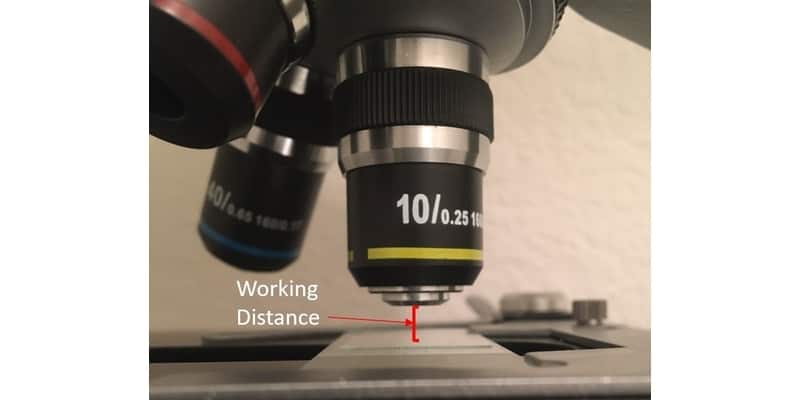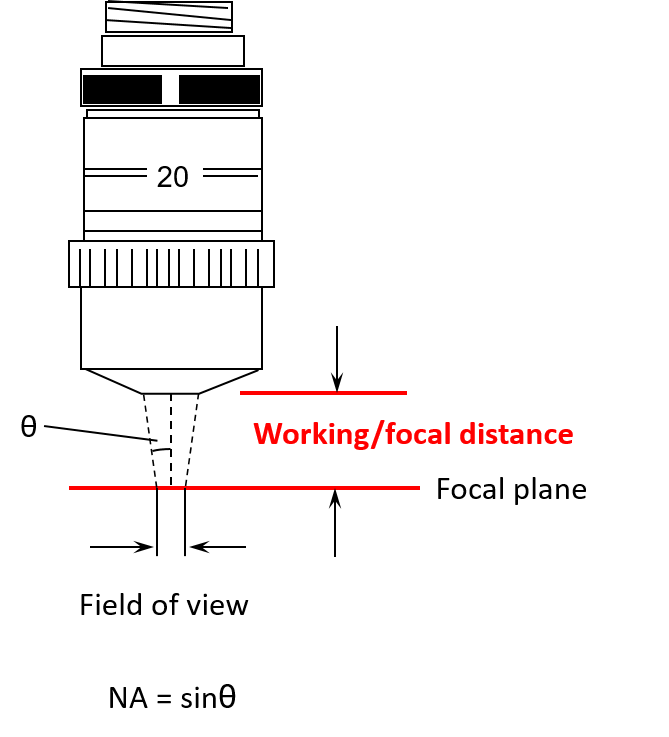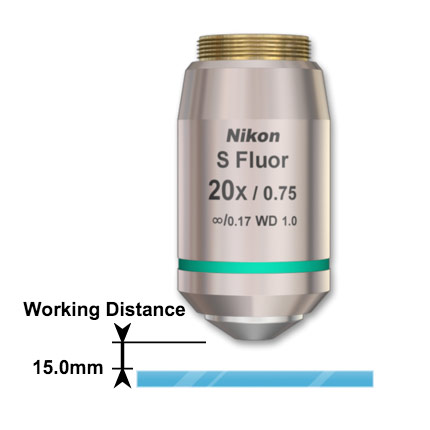calculate working distance microscope
Field Size 20 FN 6 05 Field Size 667mm At 30x magnification the entire field of view in the microscope setup mentioned above is 667mm. Max distance maintaining When referring to microscopes working distance is distance between the lens and the object being magnified.

Edexcel I A Level Biology Light Microcope Unit And Core Practical Teaching Resources A Level Biology Biology Worksheet Ecology Lessons
To determine the working distance at a focus distance other than the MFD simply plug your focus distance into the MFD value in the formula.

. The numerical aperture formula defines it as. Zoom microscopes have a fixed working distance throughout the zoom range. Distance between Microscope lens focussed object.
In the case of objectives designed to be used without coverslips the working distance is determined by the linear. Im looking for some kind of equation that shows me the inverse nature between the working distance and lets say the magnification. Microscope objectives are generally designed with a short free working distance which is defined as the distance from the front lens element of the objective to the closest surface of the coverslip when the specimen is in sharp focus.
At what magnification is the working distance greatest. In cases of specimens without cover slips linear measurement of the front lens to the specimen surface is used to calculate working distance. The working distance formula using flange focal distance is.
The f-number of a microscope is the working distance of the objective divided by the aperture diameter. The working distance is the distance from the front of the lens to the focal plane. Size of the camera sensors active area.
In the case of objectives designed to be used without coverslips the working distance is determined by. The working distance decreases as you increase magnification. The calculator can perform calculations of the third value from any two other values.
The calculator determines the focal length of a microscope objective given its magnification and the mechanical tube length for the finite conjugate microscopes or the reference focal length for infinity conjugate microscopes. The working distance of a microscope is the gap between the slide and the bottom of the microscope lens. Even when using the drop-down lists own values can be.
When you record the image to a digital medium the FOV can be expressed as a distance eg 1 mm or in calibrated pixel counts eg 1024 pixels at 1 umpixel along the major axis. N is the refractive index of the material between the objective and the sample. Depth of Field DoF.
Working distance is the distance between the front of the microscope objective lens and the surface of the specimen or slide coverslip at the point where the specimen is completely in focus. When using 10x eyepieces and a 05x objective in order to have 30x magnification the magnification knob would need to be set at 6x. The cover slip is the thin protector cover placed over a specimen.
With this in mind the depth of field can be calculated by using this formula. NA is the Numerical Aperture. Microscope objectives are generally designed with a short free working distance which is defined as the distance from the front lens element of the objective to the closest surface of the coverslip when the specimen is in sharp focus.
It is defined by the equation. As a general rule working distance decreases and total magnification increases due to the higher numerical apertures associated with high power objectives. Shooting with a lens mount other than listed in the chart.
To calculate the field of view of microscope you need to know the eyepiece magnification field number and objective lens. The stage working distance is the vertical distance. But Im still not sure how to even calculate the working distance of an objective with 2 lenses.
Also what is the working distance for a 4x objective lens. There are microscopes built with cool led lighting keeping in mind that overheating might damage sensitive slides. Lens calculator Calculating the working distance a classic.
λ lambda is the wavelength of light. This can be easily calculated by multiplying the pixel size by the sensor resolution number of active pixels in the x and y direction. Calculating the working distance using focal length object and sensor size.
Maximum range where the object appears to be in acceptable focus. Assume I had two lenses with a given NA focal length and distance apart from each other. To achieve a greater magnification of an object you must check that the working distance is large.
The high power objective lens has to be much closer to the specimen than the low-power objective lens in order to focus. It means at which distance u able to see the object clearly even at that distance u can draw the object image on paper at same time. Working distance refers to the space between the front lens element or tip of the microscope lens and the closest cover slip surface.
In general the objective working distance decreases as the magnification and numerical aperture both increase. More flange focal distances can be found on Wikipedia. A f y y 1 Note.
In general the objective working distance decreases as the magnification and numerical aperture both increase. The Numerical Aperture is defined as the ability of a lens or grouping of lenses such as a microscope objective to collect light and resolve image details at a fixed object distance. When using a 100x objective lens 1000x total power your working distance might only be 004mm 40µm.
Microscope magnification is the microscopes ability to enlarge an image of an object through a series of lenses to a size multiple times larger than the actual size of the object. WD MFD - mfgLL - FFD. It decreases as magnification resolution and numerical aperture increase.
A f y y 1 using sensor information. D n² NA² NA² Where d is the depth of field λ is the wavelength of the light from the light source n is the refractive index of the medium between the specimen and the objective lens and NA is the numerical aperture of the objective lens. Working distance defined Zygo The working distance is the distance from the front of the lens to the focal plane.
Working Distance and Parfocal Length. The working distance WD is determined by the linear measurement of the objective front lens to the focal plane. Working distance can range from 50 mm for dissecting or stereo microscope objectives to less than 01 mm for high-power oil immersion objectives.
Object to lens distance where the image is at its sharpest focus. How does the distance between the end of the objective lens and the specimen in an upright microscope change from low magnification to high magnification. In most cases the material between the objective and sample is air and n equals 100.
The formula for the depth of field is. The working distance is the distance between the specimen and objective lens. To calculate the magnification on a microscope multiply the magnification power of the eyepiece you are using by the objective currently in position.
Microscope objectives are usually designed with short working distances. The working distance is the distance from the front of the lens to the focal plane. The field of view formula is below.
The working distance WD is determined by the linear measurement of the objective front lens to the focal plane.

Boolean Algebra Calculator Circuit Working And Applications Algebra Calculator Algebra Calculator

Microscope Task Cards Are Here Task Cards Scientific Method Task Cards Framed Words

Natural Sciences Grade 9 Biology Facts Science And Nature Medical Laboratory Science

Understanding Microscopes And Objectives Edmund Optics

What Is Working Distance Microscope Clarity

Working Distance Optical Profilometer Training

Store Miss Hart Teacherspayteachers Com Science Lessons Teaching Science Science Biology

Microscope Introduction E Lab Distance Learning Life Science Lessons Biology Lessons Microscope

Microscope Parts Powerpoint Presentation And Activity Sheets Powerpoint Presentation Activity Sheets Powerpoint

Telescope Ccd And Eyepiece Calculator Deep Sky Watch Telescope Telescope Craft Astrophotography

How To Use A Microscope In 2022 Teaching Biology Homeschool Science Science Lessons

Microscope Task Cards Kid S Love Em Task Cards Middle School Science Teacher Teaching Science

Objective Working Distance Nikon S Microscopyu

Microscope Calculations Field Of View Depth Of Field Numerical Aperture Dover Motion

Din Standard Microscopic Optical Telescope

Microscope Labeling And Magnification Worksheet Biology Lesson Plans Worksheets Life Science Lessons

Microscope Calculations Field Of View Depth Of Field Numerical Aperture Dover Motion

